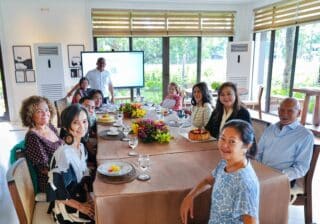A friend remarked to me the other day: “I am feeling so frustrated. I don’t feel the Christmas spirit. This COVID-19 has made this season so different from what we had in the past. I think it’s my worst Christmas ever.”
To me, the worst Yuletide season was Christmas 1941. On Dec. 7, 1941, Pearl Harbor in Hawaii was bombed by the Japanese. Forthwith, US President Franklin Delano Roosevelt declared war on Japan. Since the Philippines was an American colony, we Filipinos were likewise at war.
We learned of the sad news only the next day, Dec. 8, the Feast of the Immaculate Conception, a Catholic holy day. After our early morning Mass, my father bought the day’s papers and, after looking at the headline, he turned to us his children and said, “You’ll not be going to classes anymore. Schools have been closed and we are at war.” My young siblings were happy because of the no-classes announcement, but I was shocked and saddened. I had just turned 18 a week before and was a third-year journalism student at the University of Santo Tomas. Three months earlier, I had landed a job in the advertising department of the morning newspaper The Tribune.
That day, Dec. 8, was chaotic. News traveled fast and the radio was on the whole day. People reacted in all sorts of ways. We realized that the Japanese residents, some of whom were our neighbors, were now our enemies. But everyone’s underlying emotion was FEAR. War is ugly, and to be in the middle of it was unbearable. What was in it for us—starvation, carnage, death? Manila being the nation’s capital, it could possibly be bombed. Even then we could already hear dogfights above us. The compelling course of action was flight—get away from the city, flee as soon as possible.
My friend, Alice Lejano, age 97, remembers leaving Manila and going to her family’s town, San Carlos in Pangasinan. Food was plentiful, but this was commandeered by the Japanese authorities. And the young girls, herself included, were made to hide for fear of being taken by the soldiers. Some were recruited and later on became so-called comfort women.
My sister-in-law, Tessie Coronel, 92, was living in San Fernando, Pampanga. Because they were in the capital, her father thought it better to go to a small town away from the Japanese officers, and so they moved to Masantol.
My comadre, Ely Venzon, 86, was living in Arayat, in Pampanga, but a Japanese soldier kept coming to their house to visit her sister Nena, and so the family moved to her father’s farm.
Those of us who had no province to go to stayed in the city. Some residents built air-raid shelters in basements. On our part, from our house in Vito Cruz, we moved across the city to our ancestral house in Juan Luna, Binondo, because it was a bahay-na-bato and sturdier.
I don’t remember going to Simbang Gabi or Midnight Mass. Most probably there was none because of the blackout. I do remember, however, that on Christmas Day, we had only arroz con caldo for lunch, and we even shared it with our next-door neighbors who had no food on their table.
Right after Christmas Day, Manila was declared an Open City. A week later, 1942 was ushered in without fanfare or fireworks, but with fear and the unrealistic hope that it might bring peace. But it was not to be. We had to wait four long heavy years until the liberation of Manila in February 1945.
Lourdes Syquia Bautista, 97, is a retired UST professor. She is the mother of 12, grandmother of 27, and great-grandmother of 23.


